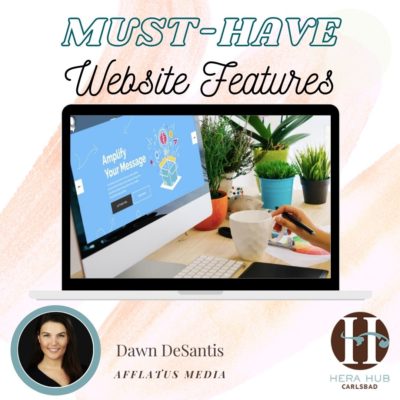
Are you ready to create a website to help your business thrive?
Your content is essential for getting the attention of search engines and those actively looking for your products and services.
Let’s assume you have web hosting and a domain name (www.yourpage.com). You have access to a content management system (CMS) like WordPress. Now it’s up to you to create content that drives people to your site.
It’s an exciting leap, but it may seem a little overwhelming. Take a deep breath. You got this. Let’s help you get started.
Basic Pages To Build
Your website should start with some basic – but important – pages. Here’s a rundown:
- Homepage: As the name suggests, this is the “home” of your website. This page is the all important “first impression” you give to your customers.
- About: Once you lured potential customers in with your homepage, they probably will want to learn more about you. The About page highlights your company’s vision, successes, and what you do to make your customers’ lives better.
- Products/Service Page: This page gives your customers a clear picture of what you are selling and how to purchase it. When creating content for this type of page, you don’t want to just explain what products you offer. You want to show how these products will benefit your customers.
- Frequently Asked Questions (FAQ) page: Have you noticed common questions customers ask you? Some people won’t take the time to ask these questions–they just find another website that can answer the questions. Including a FAQ page can help set potential customers minds’ at ease and convert the sale.
- Contact: You want to make sure you have an easy way for customers to connect with you. This page can include a contact form, your email address, physical address, phone number, and/or business hours.
- Blog: Creating regular, relevant content relating to your products or services is a great way to attract organic (FREE) traffic.
- Portfolio or Client Testimonials: Potential customers like to hear what others have to say about a product or service. This means genuine testimonials addressing a potential customer’s “pain points”.

Creating Content: Your Words Make or Break Sales
Every page needs focused content giving your audience information that leads to a sale.
Want to “WOW” people with your massive vocabulary? Write a novel or visit an Ivy League school. Want to convert sales? Write like you are talking to someone just entering high school. No, don’t belittle. Just make your language simple. Skip the obscure words and extra syllables. It only distracts readers. And, well, distracted people find somewhere else to go.
Newbies creating website content often make this mistake. Unless you are selling products or services to scientists or brain surgeons (always be mindful of your audience), keep your words and sentences short.
People’s attention spans are not like they used to be. Don’t overwhelm. The “back” button is easy to hit. Customers WILL leave your site if they feel confused or disengaged.
That’s just how it is.
Did that seem to much like preaching? Sorry, but it is a VERY important point.
Integrating Keywords to Your Content
Search engines use keywords (or phrases) to filter results essentially giving users the ability to find what they really want or need. Making sure your content is search engine optimized (SEO) with relevant keywords brings FREE traffic. That’s right…no expensive ads.
Think of what someone would type into a search engine to find your business. For example, If you are providing coaching services in the California bay area, you may want to consider “San Francisco Life Coaching”. You would want to include this keyword phrase in your content, title, and meta descriptions (more on this later).
In general, try to use a keyword for every 100-150 words.
There are plenty of ways to research the best keywords for your content. This, of course, may take time and money. Also, SEO rules are constantly changing as search engines evolve.
Keep an eye out for our upcoming blog about basic SEO practices.
Sound a little confusing? Afflatus Media has a team of experts that ensures all aspects of your website are SEO optimized.
A few more tips about writing content:
- Avoid vague business lingo: Your company may increase “productivity” and “synergy”. Don’t just say it…show it.
Example: After clients used our coaching services, the sales team reported a 55% increase in conversions after 2 months.
- Tell stories when relevant: People get absorbed by stories. It’s human nature. People want to see what unfolds.
Example: Mary was a single mother who often felt isolated and exhausted. She had a dead end job that barely fed her kids. After a couple sessions with Mary, we were able to identify some of the thoughts and beliefs holding her back from happiness. Mary began to see the light at the end of a long, dark tunnel. After the third session she bravely…” Interested in what happens next? That’s the point.
- Focus on benefits: Your product may be amazing. It may be faster, lighter, and longer-lasting because of the design. Engineers love details. Customers want to know how it works for them.
Example: The 75 Horse Power Vacuum with a 360 degree swivel base. Sounds pretty cool? Not really. Try this: “You no longer have to worry about lingering dirt and dust–even under the couch. Our vacuum makes it easy to get to those hard to reach areas. It’s so powerful even a couple Legos or a stray granola bar wrapper won’t affect the suction.”
Ready to get started? Let’s talk about creating your page.

Making A Webpage
If you made it this far….GREAT! Here’s good news: Content management systems (CMS) like WordPress make it very easy to add content to your website. In many ways, it’s like a word processing program. Of course, when you are done, you hit the “Publish” instead of the “Print” button. The result: Your new webpage.
By now, we hope you have a pretty good idea of what you need to say. Now let’s talk about how to present it.
Break Up Your Content
The way you organize your content helps keep your customers engaged. It also helps with your search engine rankings.
A page with lots of long paragraphs and nothing else is essentially a death sentence for your website. These days, people access the web with their phones or tablets. They don’t want to scroll down without seeing any white space. They want to learn things fast.
Outline Your Text with Clear Markers
The best way of doing this is by using headers. What’s that? Scroll up for a minute. See the bold phrases that are larger than the normal text. That’s headers. They are basically the outline of your content that readers can quickly scan and read what interests them.
They are easy to add. There’s usually a dropdown menu where you can highlight text and assign it as H1, H2, H3…all the way down to normal text.
For your website to be readable and rank well with search engines, you want to make sure you have less than 300 words of text between any set of headers.
In between headers, you can further break down your content with bullets. These are lists separated by dots or other symbols. Bullets are great for defining a list of terms or highlighting your product or service’s BENEFITS.
Like headers, bullet lists are easy to format. If you’ve made it this far, you’ve already seen a couple different bullet lists in this article.
Finally, don’t be afraid to use bold, italics, or CAPS in your content. Use it to highlight important points. But don’t overdo it. Overusing these tools can be DISTRACTING to YOUR ultimate message.
See what we mean?
Have a Call to Action
You created your content. You formatted everything so it is readable. Great!
Now don’t leave your customers wondering what to do next. Give them an easy opportunity to take the next step.
This is a call to action (CTA).
When creating a CTA, you need to determine what you want your customer to do. This can include several things:
- Calling for a consultation
- Visiting your Ecommerce page
- Subscribing to a mailing list
- Sharing your content on social media
- Purchasing a specific product
- Register for a free trial or guide
- And more…
Important: Keep it simple. The call to action should only address ONE of the above actions. When you give too many choices, it distracts readers.
Bad CTA example: Feel free to email, call, or fill out our form to find out how we can help you.
Effective CTAs are simple, actionable, and reach potential customers when they are most interested in your product.
A few simple, but effective CTAs include:
- Shop Now
- Try it Free
- Let’s Connect
- Call us today at [phone number]
- Save 30% Now
- I’m Ready
- See How We Can Help
CTAs can be links, but they tend to be more effective as buttons. Those are the little squares that are easy to see and click on. That click sends them to the page you want them to view.
See how it stands out?
Creating and formatting buttons is easy with content management systems like WordPress.
Now let’s tie up a few more important loose ends.
Finishing Touches Creating a Website
Here are a couple more things you want to do before you publish your webpage for the word to see.
- Title: Make sure the title of your page includes a desired keyword to help with rankings. Also, make sure desired keyword(s) appear in the first 200 words of text.
- Header image: Web pages and blog posts have the option of adding a header image to the page. These appear above the content and below the page’s navigation bar. Choose a relevant image to make a good first impression. Header images are often used when sharing the page or blog on social media. Add text to the images–like the title–so readers understand what they are clicking on.
- Adding images within the text: Headers, bullets, and white space help make your content easily digestible. Adding a couple relevant images throughout your articles and posts can help illustrate key points. When adding an image, make sure to add alt text (a brief description if the picture doesn’t load correctly).
- Meta Descriptions: Your CMS should have a section where you can modify your page’s meta description. This is a short description of your page that appears on search engine results. Though short (up to 275 characters) they can have an impact on your search rankings. Make sure to incorporate keywords into your meta descriptions.
- Social Sharing Buttons: WordPress and other CMS systems have free plug-ins you can add to make it easy for others to share your pages and posts. One click and you get some word-of-mouth exposure.
Made it This Far? Great! Hit “Publish”!
It’s exciting publishing the first page for your website. And, maybe, a little scary. Remember: this is a website…nothing is set in stone.
As you learn more great techniques for building a website, you can modify old posts and pages to your heart’s content.
Ready to Build Your Website?
You can be honest. After all, we covered a LOT of ground with this post. These basics give you a good foundation to building a website that helps your business attract more customers and GROW.
Of course, not everyone has the time and resources to get an effective, traffic-attracting website up and running. Many businesses turn to experts in the field to save time and costly errors.
Afflatus Media will help get your website up and running and make sure it is optimized so search engines notice. And, as you know, search engines bring motivated and FREE traffic.

 Dawn DeSantis is the CEO of Afflatus Media and resident search engine optimizer. An innate talent with software and a drive to root out and solve complex problems lead her to SEO. She fell in love with SEO because search engine optimization is not one thing, it’s a complex web of things that is a balance of art and science, it requires left brain and right brain concentration – which is uniquely satisfying.
Dawn DeSantis is the CEO of Afflatus Media and resident search engine optimizer. An innate talent with software and a drive to root out and solve complex problems lead her to SEO. She fell in love with SEO because search engine optimization is not one thing, it’s a complex web of things that is a balance of art and science, it requires left brain and right brain concentration – which is uniquely satisfying.
Dawn is also the Search Engine Optimization (SEO) & Search Engine Marketing (SEM) GURU at Hera Hub Carlsbad. Meet with her for a free consultation using the Calendly link here.
Learn more about Afflatus Media: https://afflatusmedia.com
Email: dawn@afflatusmedia.com
